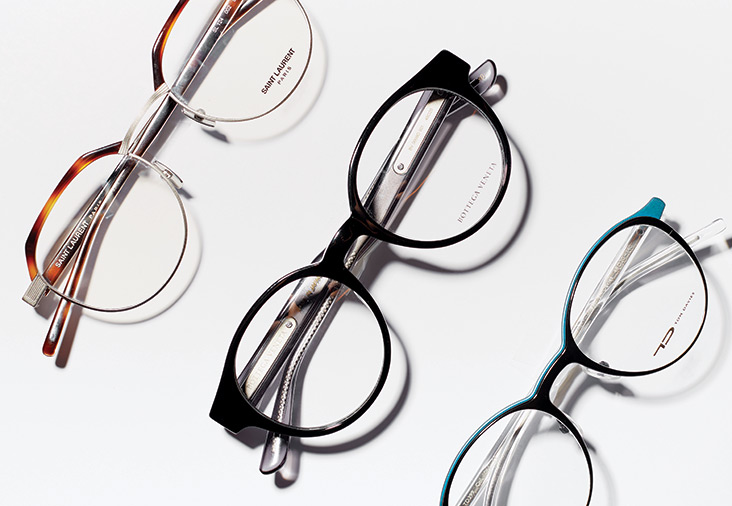For Our Eyes Only
- photos by Keith Borgmeyer.
- eyewear courtesy of Advanced Vision.
- modeled by Dianne Bollinger.

Caring for our vision as we age.
It’s easy to take our vision for granted. As we age, it’s inevitable that we’ll face one challenge or another with the health of our eyes, so it’s important to be vigilant about any changes going on with our sight.
What are some of the most prevalent problems and how can we watch for potential warning signs to assure we’re attentive to our eyes?
Cataracts
Don’t see as well driving at night? Walk into a dimly lit movie theater and not see well? Cataracts may be the problem.
“The most common symptoms of cataracts include a decrease of color in your vision, a decrease in nighttime vision, and seeing halos,” says Dr. Timothy McGarity, cataract surgeon for Restoration Eye Care. Cataracts start out small, only clouding part of the eye lens, and grow gradually. As the cataract worsens, vision can go dull or blur, and the lens will turn yellowish or brownish.
McGarity says the number one cause of cataracts is UV light exposure. “Wearing UV-blocking sunglasses and broad-brimmed hats can keep your eyes safe. Everyone is at risk, including children and senior citizens.”
Thankfully, treatment is available. Early symptoms of a cataract could improve with new glasses, better lighting, or magnifying lenses. If not, “the good news is that cataracts are easily fixed with surgery, which puts in a permanent implant resembling a prescription lens,” McGarity says.
Reduce the risks: although considered an age-related challenge, people can begin to develop cataracts in their 40s and 50s. Avoid smoking, wear hats and sunglasses that are UV protected or polarized, and adopt a high antioxidant diet (berries, grapes, nuts, dark green and orange veggies, and whole grains).
Macular Degeneration
If you’re struggling to read, watch TV, or do up-close work, you may be affected by macular degeneration, which affects the macula, the area of central vision in the eye that is made of light-sensing cells.
“Macular degeneration or age-related macular degeneration is a disease of the retina that causes people to lose central vision, rendering them unable to discern anything with fine detail,” says McGarity. “Yet these same people continue to have normal peripheral vision.”
“Many times, initial symptoms are missed by patients but caught during an eye exam,” says Dr. Sahba Jalali, optometrist for Advanced Vision. “Some symptoms will include a blurry area, or a blank or dark spot, or loss of brightness in the eye field.”
AMD is at least partially hereditary, but being older than 50, smoking, eating a diet high in saturated fat, and obesity are also important risk factors. “There is no prevention of AMD,” McGarity says, “But regular checkups can detect it early, and there are some promising treatments already and new ones on the horizon. “
Reduce the risks: don’t smoke, exercise regularly, adopt a high antioxidant diet, and maintain a healthy weight.

Glaucoma
When the optic nerve doesn’t get enough nutrients, it starts to atrophy, leading to loss of vision. Glaucoma causes a loss of peripheral vision that can be so gradual that 50 percent of sufferers don’t know they have it, Jalali says.
The optic nerve is made up of more than a million nerve fibers, and it connects the brain to the retina. High blood pressure is a risk factor for optic nerve damage, as is an increase in eye pressure, which can be monitored with eye exams.
Genetics play a large role, Jalali says. Certain ethnicities, like Scandinavian, Inuit, African, Japanese, Hispanic, Irish, and Russian, are at risk. Do you have a high prescription or have had an eye injury? You’re at risk as well.
Reduce the risks: maintain cardiovascular health, maintain a healthy weight, and don’t smoke.
Presbyopia
Meaning “old eye” in Greek, presbyopia is a natural change that effects the elasticity of the internal lens of the eye. The result? A loss of clarity and focus when reading up-close materials and a need for progressive lenses.
Symptoms include more difficulty reading close or small things, eye strain, and headaches. You may find yourself holding reading material an arm’s distance away.
“It’s a great human unifier,” Jalali says of the condition. “Every human being will go through that.”
Presbyopia affects most people between ages 39 to 49, whether or not you wear glasses or contacts already. If you can’t bring reading material closer than 14 inches before it blurs, it’s time for an eye appointment.
Posterior Vitreous Detachment
Vitreous fluid is a gel substance contained in a balloon attached to the retina, and it keeps the eye from collapsing. After age 50, the balloon can start to separate from the retina, resulting in visible “floaters,” cobwebs, or flashing lights.
“It can be described as a bug or gnat flying around,” McGarity says. “People often swat at it until they realize it’s not in front of them.”
Even a mild case of floaters needs to be checked out by a doctor, as it could lead to torn or detached retinas, Jalali says. If you see a sudden increase in floaters or flashes of light in your vision, you may be experiencing vitreous detachment, but the only way to diagnose the problem is during an eye exam.
“Vitreous detachment is much more common as we age,” McGarity adds. “If it happens in one eye, it is likely to spread to the other.”
There are ways to reduce the risk of many eye diseases. Jalali suggests regular eye exams, since many conditions don’t show early symptoms. Keep track of your family’s eye history, avoid smoking, maintain a healthy weight, and give your eyes regular breaks from the TV or computer.
Overall health is a strong indicator of eye health. Jalali says you should think of caring for your eyes as similar to caring for another vital organ: the heart. “Controlling high blood pressure, obesity, diabetes, and how many carbs we have — these are all things that affect the eye as well as the heart.”


